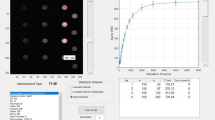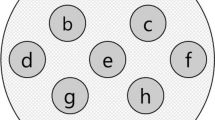Abstract
The present study was an attempt to investigate the effect of variation of inversion time (T I) and saturation time (T S) on the linear relationship between contrast agent concentration and signal intensity (SI) on Turbo Fast Low Angle Shot (TurboFLASH) T 1-weighted images in MRI. For this purpose, inversion recovery (IR) and saturation recovery (SR) sequences (Center out Phase-Encoding acquisition) were used. A phantom was designed to hold 25 vials which contained either different (between 0 and 19.77 mmol/L) or constant (1.20 mmol/L) concentrations of contrast agent. The vials of constant concentration were used for the measurement of coil non-uniformity, which was normalized to give a correction factor. The vials of different concentrations were used to measure the SI by using different sequences and different T I and T S values. To calculate the corrected SI for different concentrations, we multiplied the SI of each vial by its correction factor. The relationships between the corrected SI and the concentration [were evaluated], where the threshold of (R 2 = 0.95 and 0.99) was maintained. This study shows that different sequences and different T I and T S values can have an effect on the correlation between the SI and concentration. Regardless of the values of T I, T S, and the different IR and SR sequences chosen, the linear relationship between the SI and concentration was about twice that previously reported (i.e., 0.8 mmol/L, R 2 = 0.95).






Similar content being viewed by others
References
Sura′nyi P, Kiss P, Ruzsics B, Brott BC. Equilibrium signal intensity mapping, an MRI method for fast mapping of longitudinal relaxation rates and for image enhancement. Magn Reson Imaging. 2007;25:641–51.
Bellin MF, Van Der Molen AJ. Extracellular gadolinium-based contrast media: an overview. EJR. 2008;66:160–7.
L¨udemann L, Warmuth C, Plotkin M, F¨orschler A. Brain tumor perfusion: comparison of dynamic contrast enhanced magnetic resonance imaging using T1, T2, and T2 contrast, pulsed arterial spin labeling, and H215O positron emission tomography. EJR 2008; in press.
Takeda M, Katayama Y, Tsutsui T, Komeyama T, Mizusawa T. Dose gadolinium-diethylene triamine pentaacetic acid enhanced MRI of kidney represent tissue concentration of contrast media in the kindey? In vivo and in vitro study. Magn Reson Imaging. 1994;12:421–7.
Canet E, Douek P, Janier M, Bendid K, Amaya J, Millet P, et al. Influence of bolus volume and dose of gadolinium chelate for first-pass myocardial perfusion MR imaging studies. J Magn Reson Imaging. 1995;4:411–5.
Mørkenborg J, Pedersen M, Jensen FT, Stødkilde-Jørgensen H, Djurhuus JC, Frøkiær J. Quantitative assessment of Gd-DTPA contrast agent from signal enhancement: an in vitro study. Magn Reson Imaging. 2003;21:637–43.
NessAiver M, editor. All you really need to know about MRI physics, Chapters 6 and 7, 1 ed. University of Maryland Medical Center, USA; 1997.
Nazarpoor M, Moody AR, Martel AL, Morgan PS. The relationship between contrast agent concentration and signal intensity on T1 weighted images for measuring perfusion with MRI. 20th Annual Scientific Meeting, ESMRMB Rotterdam 2003; p. S243–4.
Roberts TPL. Physiological measurement by contrast-enhanced MR imaging: expectations and limitations. J Magn Reson Imaging. 1997;7:82–90.
Bernstein MA, King KF, Zhou XJ. Handbook of MRI pulse sequences. London: Academic Press; 2004.
Nazarpoor M. The effect of repetition time on the relationship between contrast agent concentration and signal intensity on T1-weighted images using inversion recovery (IR) sequence. European Society for Magnetic Resonance in Medicine and Biology (ESMRMB), Copenhagen, Denmark 2004; p. S310–1.
Rohrer M, Bauer H, Mintorovitch J, Requardt M, Weinmann HJ. Comparison of magnetic properties of MRI contrast media solution at different magnetic field strengths. Invest Radiol. 2005;40:715–24.
McRobbie DW, Moore EA, Graves MJ, Prince MR. MRI from protons to pictures. Cambridge: Cambridge University Press; 2006. p. 69.
Simmons A, Tofts PS, Barker GJ, Arridge SA. Sources of intensity non-uniformity in spin echo images at 1.5 T. Magn Reson Med. 1994;32:121–8.
Kleinbaum DG, Kupper LL, Muller KE. Applied regression analysis and other multivariable methods, chapter 6. Duxbury Press, Wadsworth publishing company, Inc edition; 1998.
Unger EC, Ugurbil K, Latchaw RE. Contrast agent for cerebral perfusion MR imaging. J Magn Reson Imaging. 1994;4:235–42.
Fritz-Hansen T, Rostrup E, Ring PB, Larsson HBW. Quantification of gadolinium-DTPA concentrations for different inversion times using an IR-Turbo FLASH pulse sequence: a study on optimizing multislice perfusion imaging. Magn Reson Imaging. 1998;8:893–9.
Dean BL, Lee C, Kirshch JE, Runge VM, Dempsey RM, Pettigrew LC. Cerebral hemodynamics and cerebral blood volume: MR assessment using gadolinium contrast agents and T1-weighted Turbo-FLASH imaging. Am J Neuroradiol. 1992;13:39–48.
Valle′e JP, Lazeyras F, Kasuboski L, Chatelain P, Howarth N, Righetti A, et al. Quantification of myocardial perfusion with FAST sequence and Gd bolus in patients with normal cardiac function. J Magn Reson Imaging. 1999;19:197–203.
Bourke GJ, Daly LE, Gilvray JM, editors. Interpretation and uses of medical statistics, 3rd ed. Oxford: Blackwell Scientific Publications; 1985.
Moody AR, Martel A, Kenton A, Allder S, Horsfield MA, Delay G, et al. Contrast-reduced imaging of tissue concentration and arterial level (CRITICAL) for assessment of cerebral hemodynamics in acute stroke by magnetic resonance. Invest Radiol. 2000;35:401–11.
Author information
Authors and Affiliations
Corresponding author
About this article
Cite this article
Nazarpoor, M. Effects of inversion and saturation times on relationships between contrast agent concentrations and signal intensities of T 1-weighted magnetic resonance images. Radiol Phys Technol 3, 120–126 (2010). https://doi.org/10.1007/s12194-010-0087-9
Received:
Revised:
Accepted:
Published:
Issue Date:
DOI: https://doi.org/10.1007/s12194-010-0087-9




